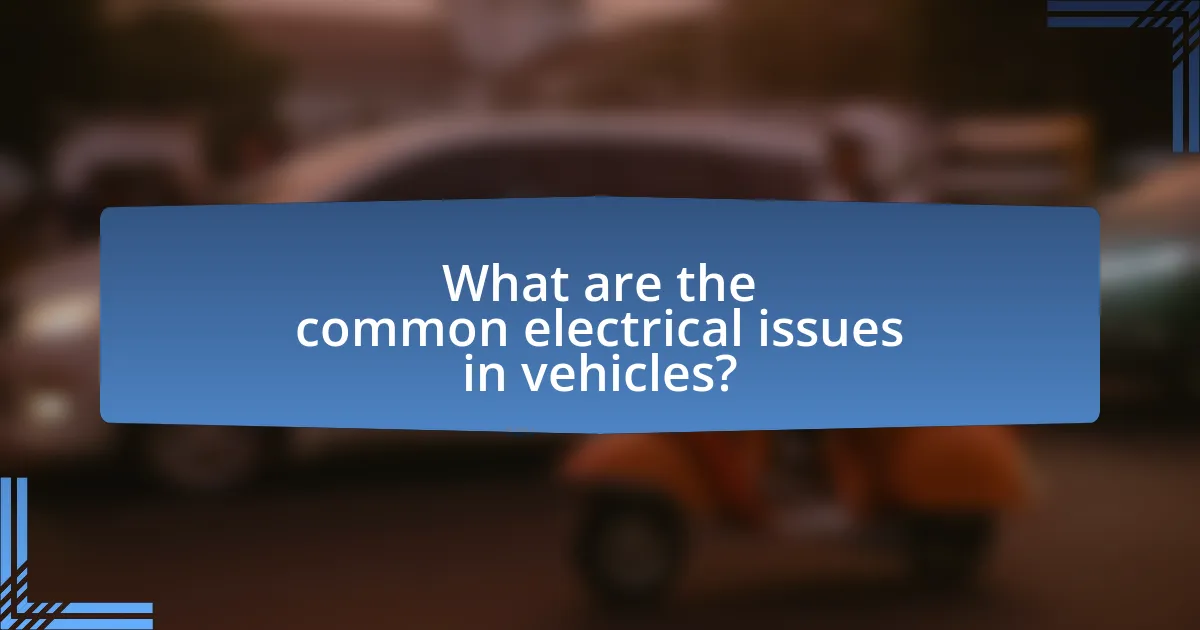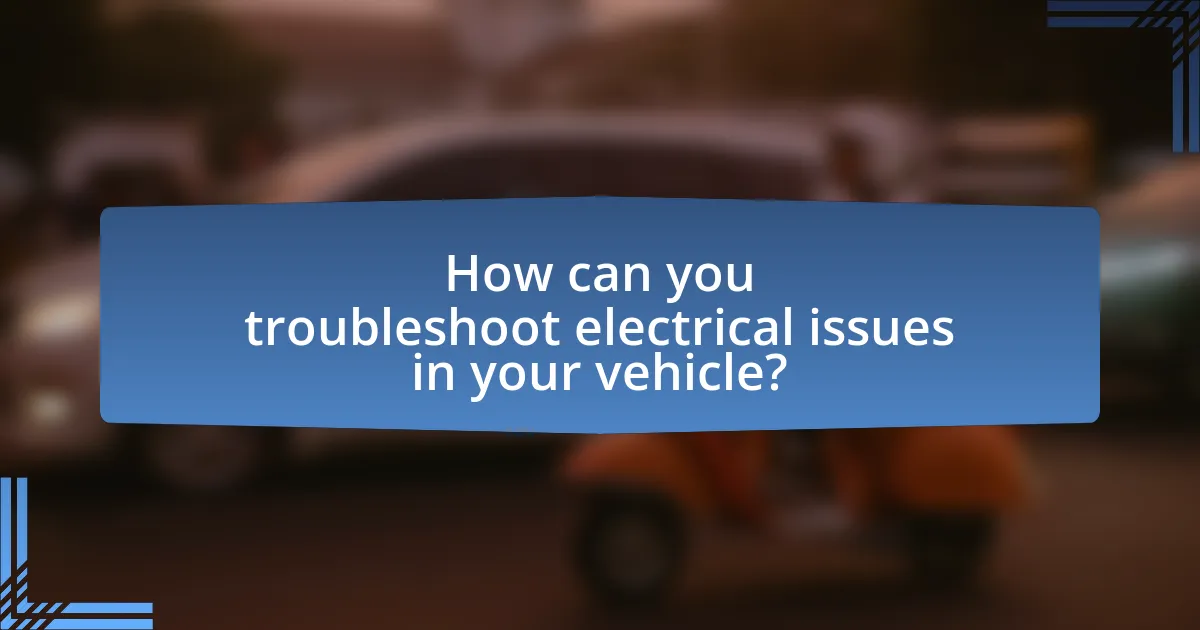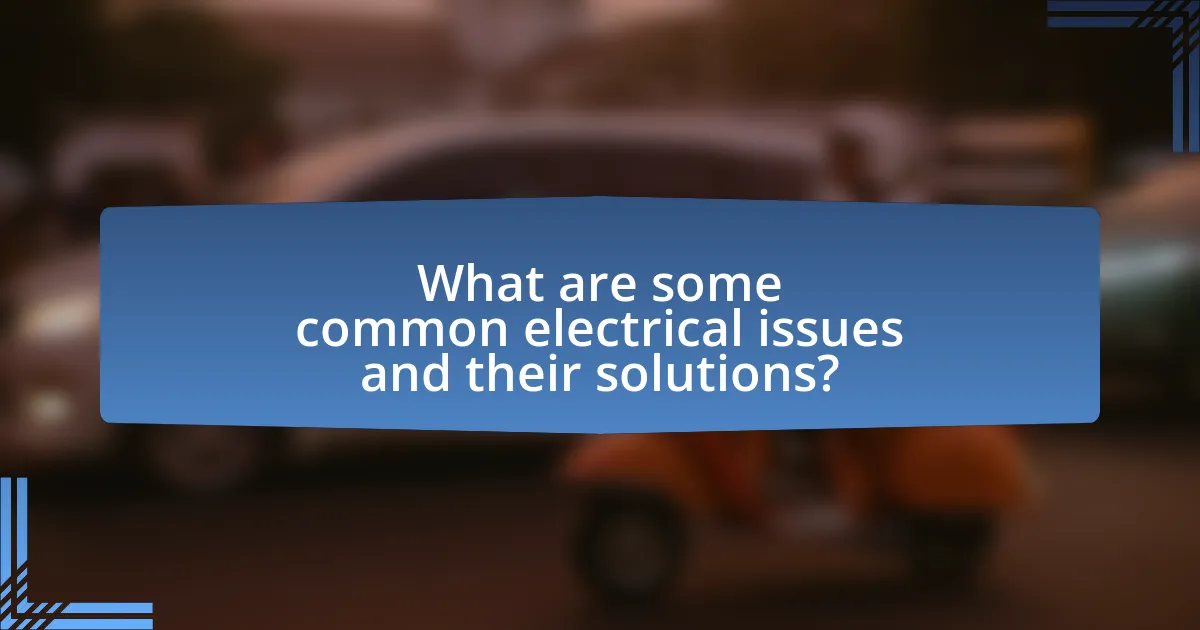The article focuses on troubleshooting electrical issues in vehicles, highlighting common problems such as battery failure, alternator issues, faulty wiring, blown fuses, and malfunctioning sensors. It provides guidance on identifying symptoms of electrical faults, including dimming lights and warning lights on the dashboard, and outlines diagnostic steps using tools like multimeters and circuit testers. Additionally, the article discusses preventative measures for maintaining the electrical system, emphasizing the importance of regular inspections and proper maintenance to enhance vehicle reliability and safety.

What are the common electrical issues in vehicles?
Common electrical issues in vehicles include battery failure, alternator problems, faulty wiring, blown fuses, and malfunctioning sensors. Battery failure is often caused by age or corrosion, leading to starting issues. Alternator problems can result in insufficient power to recharge the battery, causing electrical components to fail. Faulty wiring may lead to shorts or open circuits, disrupting the electrical flow. Blown fuses protect circuits from overloads, and when they blow, specific systems may stop functioning. Malfunctioning sensors can affect various vehicle systems, including the engine and transmission, leading to performance issues. These issues are frequently diagnosed through visual inspections and electrical testing.
How can you identify electrical problems in your vehicle?
To identify electrical problems in your vehicle, start by observing warning lights on the dashboard, as these indicators often signal issues with the electrical system. Additionally, check for symptoms such as dimming headlights, malfunctioning power windows, or issues with the ignition system, which can all point to electrical faults. Testing the battery voltage with a multimeter can provide concrete evidence of battery health, as a reading below 12.4 volts typically indicates a weak battery. Furthermore, inspecting fuses for any blown components can help pinpoint electrical failures, as a blown fuse often interrupts the circuit and causes specific electrical functions to fail.
What symptoms indicate an electrical issue?
Symptoms indicating an electrical issue in a vehicle include dimming or flickering lights, malfunctioning dashboard indicators, and difficulty starting the engine. These symptoms suggest potential problems with the battery, alternator, or wiring. For instance, dim lights often indicate a weak battery or poor connections, while dashboard indicators that fail to illuminate can signal a blown fuse or faulty wiring. Difficulty starting the engine may point to a failing starter or battery. Identifying these symptoms early can prevent further electrical failures and ensure vehicle reliability.
How do warning lights relate to electrical problems?
Warning lights indicate electrical problems by signaling malfunctions in the vehicle’s electrical system. These lights are connected to various sensors and control modules that monitor critical functions, such as battery voltage, alternator performance, and overall electrical integrity. For instance, a battery warning light may illuminate if the alternator is not charging the battery properly, indicating a potential electrical failure. Additionally, diagnostic trouble codes generated by the vehicle’s onboard computer can pinpoint specific electrical issues, further validating the relationship between warning lights and electrical problems.
What are the most frequent causes of electrical failures?
The most frequent causes of electrical failures in vehicles include faulty wiring, corroded connectors, and malfunctioning components such as the battery or alternator. Faulty wiring can lead to short circuits or open circuits, disrupting the electrical flow necessary for vehicle operation. Corroded connectors impede electrical connections, resulting in intermittent failures or complete loss of power. Additionally, a failing battery or alternator can cause insufficient power supply, leading to various electrical issues. According to the National Highway Traffic Safety Administration, electrical system failures are a significant contributor to vehicle breakdowns, underscoring the importance of regular maintenance and inspection of these components.
How do battery issues contribute to electrical failures?
Battery issues contribute to electrical failures by causing insufficient power supply to the vehicle’s electrical systems. When a battery is weak, corroded, or improperly connected, it can lead to voltage drops, which disrupt the operation of critical components such as the starter, lights, and onboard electronics. For instance, a study by the Society of Automotive Engineers found that nearly 30% of electrical failures in vehicles are linked to battery-related problems, highlighting the importance of maintaining battery health for reliable electrical performance.
What role do fuses play in vehicle electrical systems?
Fuses serve as protective devices in vehicle electrical systems by preventing excessive current flow that can cause damage to electrical components. When the current exceeds a predetermined level, the fuse melts and breaks the circuit, thereby safeguarding wiring and devices from overheating or failure. This function is critical in maintaining the integrity of the vehicle’s electrical system, as it helps to avoid costly repairs and potential safety hazards associated with electrical fires or component damage.

How can you troubleshoot electrical issues in your vehicle?
To troubleshoot electrical issues in your vehicle, start by checking the battery and its connections for corrosion or loose terminals, as these are common sources of electrical problems. Next, inspect fuses and relays for any blown components, which can interrupt electrical flow. Use a multimeter to test voltage at various points in the electrical system, ensuring that power is reaching critical components like the starter and ignition system. Additionally, examine wiring for any signs of damage or wear, as frayed wires can lead to shorts or open circuits. According to the National Highway Traffic Safety Administration, many electrical issues stem from poor connections or faulty components, making these checks essential for accurate diagnosis.
What tools are necessary for troubleshooting electrical problems?
To troubleshoot electrical problems in vehicles, essential tools include a multimeter, a test light, wire strippers, and a circuit tester. A multimeter measures voltage, current, and resistance, allowing for precise diagnostics of electrical components. A test light helps identify power and ground issues by illuminating when connected to a live circuit. Wire strippers are necessary for safely removing insulation from wires to make connections or repairs. A circuit tester checks for continuity in circuits, ensuring that electrical paths are intact. These tools are fundamental for effectively diagnosing and resolving electrical issues in vehicles.
How do you use a multimeter for diagnostics?
To use a multimeter for diagnostics, first set the multimeter to the appropriate measurement mode, such as voltage, current, or resistance, depending on what you need to test. For example, to check battery voltage, select the DC voltage setting and connect the probes to the battery terminals; a healthy battery should read around 12.6 volts. When measuring resistance, ensure the circuit is powered off, set the multimeter to the resistance mode, and connect the probes to the component being tested; a reading of zero indicates continuity, while an infinite reading suggests a break in the circuit. This method is validated by the multimeter’s ability to provide accurate readings, which are essential for diagnosing electrical issues effectively.
What other tools can assist in troubleshooting?
Multimeters are essential tools that assist in troubleshooting electrical issues in vehicles. They measure voltage, current, and resistance, allowing technicians to diagnose problems accurately. Additionally, oscilloscopes can visualize electrical signals, helping to identify irregularities in circuits. Scan tools are also valuable, as they read diagnostic trouble codes from the vehicle’s computer, providing insights into potential faults. Furthermore, circuit testers can verify the integrity of electrical connections, ensuring that power is reaching the necessary components. These tools collectively enhance the troubleshooting process by providing precise measurements and diagnostics.
What steps should you follow to diagnose electrical issues?
To diagnose electrical issues in a vehicle, follow these steps: first, visually inspect the wiring and connections for any signs of damage or corrosion. Next, use a multimeter to check for voltage at various points in the electrical system, ensuring that power is reaching components like the battery, fuses, and relays. Then, test individual components, such as switches and sensors, to confirm they are functioning correctly. Additionally, consult the vehicle’s service manual for specific troubleshooting procedures related to the electrical system. These steps are validated by standard automotive repair practices, which emphasize systematic inspection and testing to identify faults effectively.
How do you check the battery and connections?
To check the battery and connections, first, visually inspect the battery for any signs of corrosion, damage, or loose connections. Ensure that the battery terminals are clean and tightly secured, as loose or corroded connections can lead to electrical issues. Next, use a multimeter to measure the battery voltage; a healthy battery should read around 12.6 volts or higher when the vehicle is off. If the voltage is below 12.4 volts, the battery may be weak and require charging or replacement. Additionally, check the connections of the battery cables to the starter and ground to ensure they are secure and free of corrosion, as poor connections can hinder electrical flow.
What is the process for inspecting fuses and relays?
The process for inspecting fuses and relays involves visually examining the components and testing their functionality. First, locate the fuse box and relay panel in the vehicle, which is typically found under the dashboard or in the engine compartment. Next, remove the fuses and relays one at a time, checking for any visible signs of damage such as burn marks or broken elements. For fuses, use a multimeter to test continuity; a lack of continuity indicates a blown fuse. For relays, test the relay by applying power to the control circuit and checking for a clicking sound or voltage output at the load terminals. This method ensures that both fuses and relays are functioning correctly, which is essential for resolving electrical issues in vehicles.

What are some common electrical issues and their solutions?
Common electrical issues in vehicles include dead batteries, faulty alternators, blown fuses, and malfunctioning starter motors. A dead battery can be resolved by jump-starting or replacing the battery. Faulty alternators can be diagnosed through voltage testing; if the alternator is not charging the battery, it should be replaced. Blown fuses can be identified by checking the fuse box; replacing the blown fuse with one of the same amperage will restore functionality. Malfunctioning starter motors can be tested by checking for power at the starter; if there is no power, the starter may need replacement. These solutions are based on standard automotive repair practices and can effectively address common electrical issues.
How can you fix a dead battery issue?
To fix a dead battery issue, jump-start the vehicle using jumper cables and a functioning battery from another vehicle. Connect the positive terminal of the dead battery to the positive terminal of the working battery, and then connect the negative terminal of the working battery to a grounded metal surface on the vehicle with the dead battery. This method is effective because it allows the dead battery to receive a charge from the working battery, enabling the vehicle to start. According to the National Highway Traffic Safety Administration, proper jump-starting techniques can prevent damage to the vehicle’s electrical system and ensure safety during the process.
What are the steps to jump-start a vehicle?
To jump-start a vehicle, first, gather a set of jumper cables and a functioning vehicle with a charged battery. Next, park the functioning vehicle close to the vehicle with the dead battery, ensuring both are turned off. Connect one end of the red jumper cable to the positive terminal of the dead battery and the other end to the positive terminal of the charged battery. Then, connect one end of the black jumper cable to the negative terminal of the charged battery and the other end to an unpainted metal surface on the dead vehicle, away from the battery. Start the functioning vehicle and let it run for a few minutes. Finally, attempt to start the vehicle with the dead battery. If successful, remove the cables in reverse order: black from the metal surface, black from the charged battery, red from the charged battery, and red from the dead battery. This method is effective because it allows the charged battery to transfer power to the dead battery, enabling the vehicle to start.
When should you replace the battery instead of jump-starting?
You should replace the battery instead of jump-starting when the battery is over three years old, shows signs of corrosion, or fails to hold a charge after multiple jump-start attempts. Batteries typically have a lifespan of three to five years, and if a battery is consistently unable to start the vehicle, it indicates that the battery’s capacity has diminished significantly. Additionally, visible corrosion on battery terminals can signal internal damage, making jump-starting ineffective. According to the Battery Council International, a battery that cannot maintain a charge after being jump-started multiple times is likely at the end of its useful life and should be replaced to ensure reliable vehicle operation.
What should you do if your lights are dim or flickering?
If your lights are dim or flickering, first check the battery connections to ensure they are tight and free of corrosion. Loose or corroded connections can lead to insufficient power supply, causing lights to dim or flicker. Additionally, inspect the alternator, as a failing alternator may not provide adequate voltage to the electrical system, resulting in similar symptoms. According to the National Highway Traffic Safety Administration, electrical issues are a common cause of vehicle malfunctions, emphasizing the importance of addressing dim or flickering lights promptly.
How can you check the alternator’s performance?
To check the alternator’s performance, use a multimeter to measure the voltage output at the battery terminals while the engine is running. A healthy alternator should produce between 13.8 to 14.5 volts. If the voltage is below this range, it indicates that the alternator may not be charging the battery effectively. Additionally, inspect the alternator belt for wear and ensure all connections are secure, as loose or corroded connections can affect performance.
What are the signs of a failing alternator?
The signs of a failing alternator include dimming headlights, electrical issues, unusual noises, and warning lights on the dashboard. Dimming headlights indicate insufficient power supply, while electrical issues such as malfunctioning power windows or radio suggest the alternator is not charging the battery effectively. Unusual noises, like grinding or whining, can signal internal damage within the alternator. Additionally, the battery warning light or check engine light may illuminate, indicating a problem with the charging system. These symptoms collectively point to a failing alternator that requires attention to prevent further vehicle issues.
What are the best practices for maintaining your vehicle’s electrical system?
To maintain your vehicle’s electrical system effectively, regularly inspect and clean battery terminals to prevent corrosion, ensuring a solid connection. Additionally, check the battery’s charge and replace it every three to five years, as batteries lose capacity over time. Inspect fuses and wiring for damage or wear, replacing any faulty components promptly to avoid electrical failures. Furthermore, ensure that all electrical connections are secure and free from moisture, as this can lead to short circuits. Regularly testing the alternator’s output can also help identify potential issues before they escalate, as a failing alternator can compromise the entire electrical system.
How often should you inspect electrical components?
Electrical components should be inspected at least once a year. Regular inspections help identify wear, corrosion, or damage that could lead to electrical failures. According to the National Fire Protection Association (NFPA), electrical failures are a leading cause of fires, emphasizing the importance of routine checks to ensure safety and functionality.
What preventative measures can you take to avoid electrical issues?
To avoid electrical issues in your vehicle, regularly inspect and maintain the battery, wiring, and connections. Ensuring that the battery terminals are clean and free from corrosion can prevent poor electrical connections, which are a common source of electrical problems. Additionally, checking the vehicle’s fuses and replacing any that are blown can help maintain a stable electrical system. According to the National Highway Traffic Safety Administration, routine maintenance can significantly reduce the risk of electrical failures, enhancing vehicle reliability and safety.

